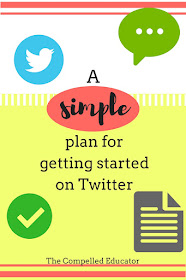I'm fired up about Monday night's quarterly #USedchat on twitter because of the topic and the guest moderator! Chris Aviles is going to be leading our conversation Monday night around the topic, Gamifying Your Classroom.
I'm sure my interest in this topic stems from my background in athletics. My husband and I love to play all sorts of games (board, card, physical/athletic, electronic), and we've raised our girls to love games as well. I incorporated games in my classroom while I was a classroom teacher, but it was never called "gamification." I can't wait to learn more about the topic, especially from Chris and other educators across the country in Monday's #USedchat.
Chris Aviles, our guest moderator for #USedchat, was recently recognized by ISTE as one of five Emerging Leaders.
You can read his straight-talk-style blog post about his gamified classroom over at Tech & Learning, and he'll also share feedback from his students that makes him a true believer of gamifying the classroom. He does warn us, though: "Gamification is not the be-all and end-all."
I had a few questions for Chris about "Gamifying Your Classroom," and here's what he told me.
Me: In layman's terms, what is gamification?
Chris: I find it helpful to know two definitions here, actually: Gamification vs. Game-Based Learning. Gamification is the use of game-mechanics in non-game contexts. This most often is the use of points, badges, and leaderboards in the classroom, but it can be so much more. Game-Based Learning is using (video) games to teach and assess. Think of Game-Based Learning as using games like Minecraft, Cities Skylines, or Offworld Trading Company in class to teach a concept or lesson.
Me: Why are you such a fan of gamification?
Chris: I believe in a student-centered classroom. Good Gamification is student-centered design rather than the usual content-focused design most often employed in the classroom. I love gamification because it helps be design the classroom for my students, not design my curriculum for the classroom.
Me: Does a teacher need special equipment to gamify his/her classroom?
Chris: Not at all. Gamification can be as indepth and intense as you want. I've worked with teachers and done easy, no-tech gamification and I've used some serious edtech to create an immersive classroom that blew students' minds. Gamification can be as much or as little as you want, or better yet: as much or as little as your students need.
Me: Is this something that can be done in EVERY classroom, no matter the subject area?
Chris: Can it be done in every subject and grade? Absolutely. Can it be done in every classroom? Yes. Should it be done in every classroom? No. I recently phased out most game-mechanics in a particularly engaged and motivate class because they didn't need it. Gamification is a tool and the teacher must wield it as such. There is no one size fits all in education.
Me: Are there any tech resources you would recommend for teachers who are just getting started who want to dip their toes in the "gamification waters"?
Chris: So many great educators and thought leaders bring something different and exciting to the table. Greg Toppo, Mike Matera, Steve Issacs, Matt Farber, Kevin Werbach, Jane McGonical, Yu-Kai Chou are just a few doing amazing things with gamification. TED is a great place to hear about Gamification in both an educational and broader context for those looking to be inspired.
Me: Anything teachers need to know NOT to do?
Chris: All of Gamification comes down to one thing: being fair. Remember to make your gamified classroom fair!
The interview with Chris led me to this TEDx talk by Yu-kai Chou at TEDxLausanne. He shares some of the basics about gamification, and he reminds us that points and badges don't automatically make a game fun.
Click the following link if your device won't play the video above:
Below is one more video to pique your curiosity. Paul Anderson is a biology teacher in Montana. I encourage ALL EDUCATORS to watch the video below.
Paul's opening line to his TEDx talk...
"Hello. My name is Mr. Anderson and my classroom is a video game."
Do you gamify your classroom?
Would you be willing to try?
We hope you'll join us for #USedchat Monday, July 11!










